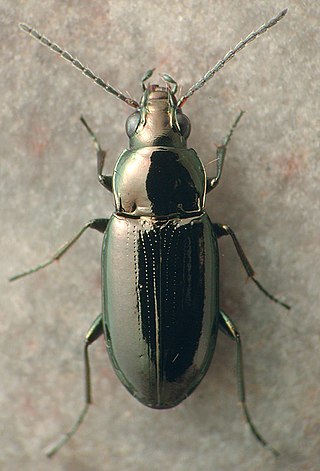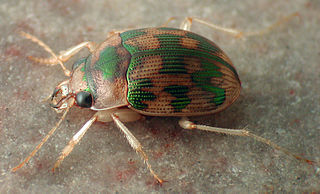Related Research Articles

Ground beetles are a large, cosmopolitan family of beetles, the Carabidae, with more than 40,000 species worldwide, around 2,000 of which are found in North America and 2,700 in Europe. As of 2015, it is one of the 10 most species-rich animal families. They belong to the Adephaga. Members of the family are primarily carnivorous, but some members are herbivorous or omnivorous.
Altagonum is a genus of beetles in the family Carabidae, containing the following species:

Gehringia olympica is a species of ground beetle of the, and the only species in the genus Gehringia.

Zeodera is a genus of ground beetles in the family Carabidae, first described by François-Louis Laporte in 1867. There are about six described species in Zeodera.
Halocoryza is a genus of beetles in the family Carabidae, containing the following species:

Tasmanitachoides is a genus of ground beetles in the family Carabidae, endemic to Australia. The beetles are very small, typically 1.5 to 3.0 mm. in length, and live in coarse sand or fine gravel along freshwater shorelines throughout Australia.
Halocoryza acapulcana is a species of brown coloured ground beetle in the subfamily Scaritinae which can be found in Ecuador and Mexico.
Halocoryza whiteheadiana is a species of brown coloured ground beetle in the subfamily Scaritinae which is endemic to Baja California Sur, Mexico.
Halocoryza maindroni is a species of brown coloured ground beetle in the subfamily Scaritinae which can be found on Comoros, Madagascar, Mauritius, Mayotte, and Réunion, as well as in Djibouti, Saudi Arabia, and Somalia.

Ross Taylor Bell was an American entomologist with particular interest in the invertebrate natural history of Vermont, United States, and carabid beetles. Together with his wife, Joyce Rockenbach Bell, his work at the University of Vermont was largely taxonomic, where they described more than 75% of the rhysodine species known to science. Ross also wrote a number of seminal papers in his chosen field.
Stefano Ludovico Straneo was an Italian entomologist, teacher, academic administrator and author.

Amara fulva is a species of ground beetle native to Europe.
Bembidion salebratum is a species of beetle in the family Carabidae. It is found in Canada and the United States.

Bembidion nitidum is a species of beetle in the family Carabidae. It is found in Canada and the United States.
Apenes parallela is a species of ground beetle in the family Carabidae.

Agonoleptus is a genus of ground beetles in the family Carabidae. There are about eight described species in Agonoleptus.
Neoelmis is a genus of riffle beetles in the family Elmidae. There are more than 50 described species in Neoelmis.

Omophron tessellatum, the mosaic round sand beetle, is a species of ground beetle in the family Carabidae found in North America. Its distribution includes the United States in states such as Arkansas, Virginia, Oklahoma, and Arizona; and in Canada in provinces such as Nova Scotia and Alberta. The species grows to lengths of 5.4 to 7 millimeters. Its habitat is flooded areas such as lake shores, river banks, ponds, pool edges, and beaches with sandy or clayish soil. It breeds in the spring from May to July.
Agra guatemalena is a species of carabid beetle. The holotype was collected in Costa Rica and first described to science in 1932 by Ernő Csíki.
John George Gehring was an American medical doctor who specialised in neurology.
References
- ↑ "Halocoryza arenaria (Darlington, 1939)". Catalogue of Life. Retrieved 2023-04-09.
- ↑ Terry L. Erwin (2011). "Halocoryza Alluaud 1919, sea-side beetles of the Indian, Atlantic (sensu lato), and Pacific Oceans: a generic synopsis and description of a remarkable new species from Baja California Sur, México (Coleoptera, Carabidae, Scaritini, Clivinina)". ZooKeys . Pensoft (127): 1–13. Bibcode:2011ZooK..127....1E. doi: 10.3897/zookeys.127.1748 . PMC 3175127 . PMID 21998544.
- ↑ Whitehead, Donald R. (March 1969). "Variation and Distribution of the Intertidal Beetle Halocoryza arenaria (Darlington) in Mexico and the United States (Coleoptera; Carabidae)". Journal of the New York Entomological Society. University of Alberta. 77 (1): 36–39. JSTOR 25006145.